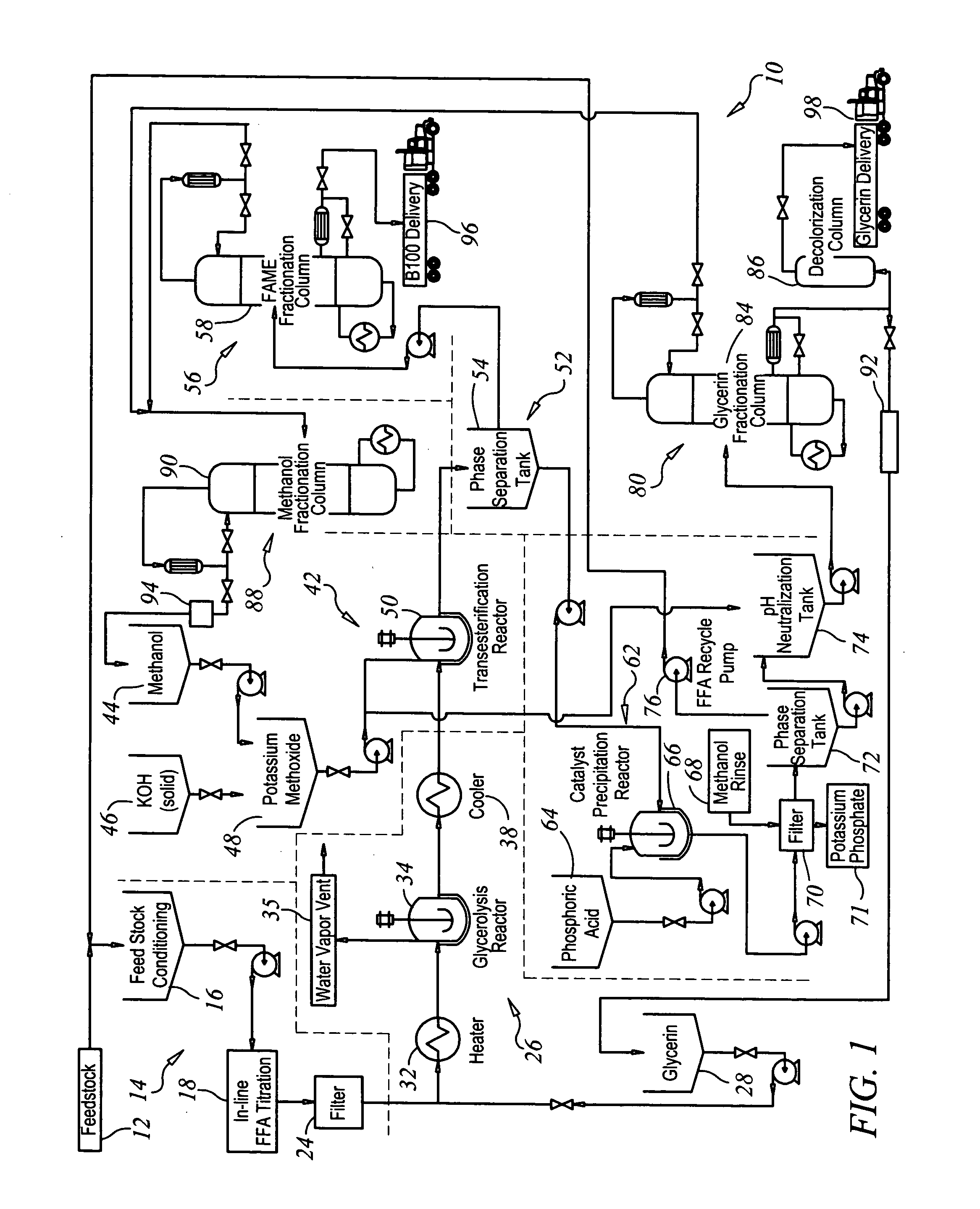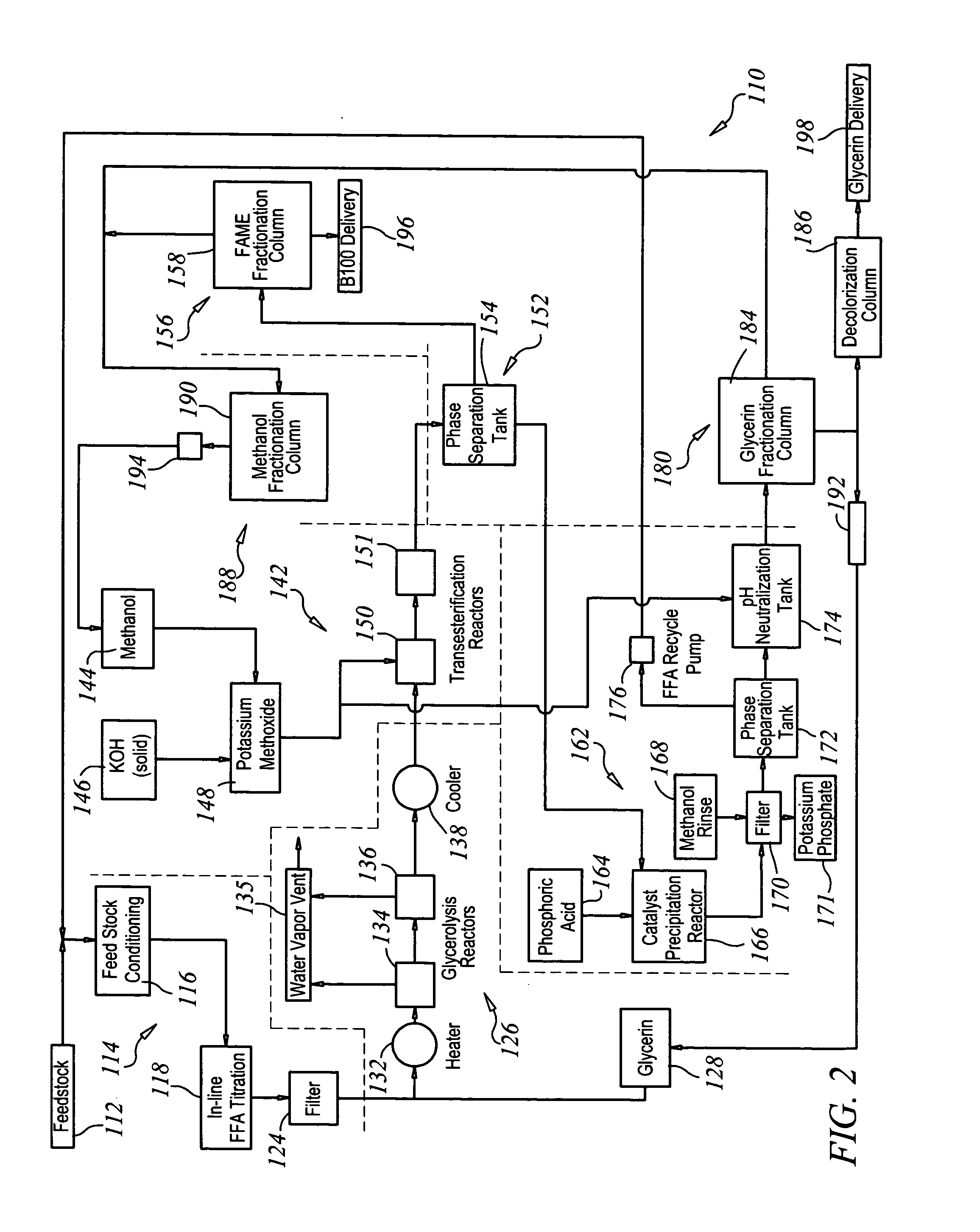Production of biodiesel and glycerin from high free fatty acid feedstocks
a technology of free fatty acid feedstock and biodiesel, which is applied in the direction of fatty acid chemical modification, fatty oil/acid recovery from waste, fatty oil/fat refining, etc. it can solve the problems of complex feedstock and difficult economic processing, and achieve high free fatty acid waste grease, efficient, cost-effective, and difficult economic processing
- Summary
- Abstract
- Description
- Claims
- Application Information
AI Technical Summary
Benefits of technology
Problems solved by technology
Method used
Image
Examples
working example no.1
WORKING EXAMPLE NO. 1
[0195] Rendered yellow grease with a free fatty acid concentration of 20 percent by weight and 2 percent moisture, impurities and unsaponafiable (MIU) was fed to a preferred embodiment of the invention at 100 pounds per minute (lbs / min). The grease was filtered and titrated intermittently as it was fed to the glycerolysis reactors. Glycerin was added at a rate of 13 lbs / min. The temperature of the grease and glycerin mixture was raised to 210° C. as it was fed into the first of the glycerolysis CSTRs. In the reactor, the pressure was reduced to 2 psia and the temperature was maintained at 210° C. The vessel is fitted with a high intensity agitator to keep the immiscible liquids in contact. Water vapor produced by the reaction was removed through vents in the reactor headspace. The residence time in each of the glycerolysis reactors was 2.5 hours. The conversion of fatty acids to glycerides in the first vessel was 85 percent. The fatty acid concentration leaving ...
working example no.2
WORKING EXAMPLE NO. 2
[0202] Fancy bleachable inedible tallow with a free fatty acid concentration of 4 percent by weight and 0.5 percent MIU (moisture, impurities and unsaponafiable) was fed to a preferred embodiment of the invention at 100 lbs / min. The grease was filtered and titrated continuously as it was fed to the glycerolysis reactors. Glycerin was added at a rate of 2.6 lbs / min. The temperature of the grease and glycerin mixture was raised to 210° C. as it was fed into the first of the glycerolysis CSTRs. In the reactor the pressure was reduced to 2 psia and the temperature was maintained. The vessel was fitted with an agitator to keep the immiscible liquids in contact. Water vapor produced by the reaction was removed through vents in the reactor headspace. The residence time in each of the glycerolysis reactors was 2.5 hours. The conversion of fatty acids to glycerides in the first vessel was 92 percent. The fatty acid concentration leaving the second reactor was maintained ...
working example no.3
WORKING EXAMPLE NO. 3
[0209] Degummed food grade soybean oil with a free fatty acid concentration of 0.5 percent by weight and 0.5 percent MIU (moisture, impurities and unsaponafiable) was fed to a preferred embodiment of the invention at 100 lbs / min. The grease was filtered and titrated continuously as it was transferred from the feedstock conditioner. Due to the low concentration of free fatty acids, the glycerolysis section of the process was bypassed when using this feedstock.
[0210] The fatty acid concentration entering the transesterification reactors was 0.5 percent by weight. The potassium hydroxide was added at a rate of 1.0 lbs / min and mixed with 22 lbs / min of methanol. The transesterification took place in two CSTRs in series, each with a two-hour residence time.
[0211] The transesterified product was then fed to a phase separation tank where the majority of the FAMEs and a small concentration of the unreacted methanol floated to the top. The glycerin, the majority of the ...
PUM
 Login to View More
Login to View More Abstract
Description
Claims
Application Information
 Login to View More
Login to View More - R&D
- Intellectual Property
- Life Sciences
- Materials
- Tech Scout
- Unparalleled Data Quality
- Higher Quality Content
- 60% Fewer Hallucinations
Browse by: Latest US Patents, China's latest patents, Technical Efficacy Thesaurus, Application Domain, Technology Topic, Popular Technical Reports.
© 2025 PatSnap. All rights reserved.Legal|Privacy policy|Modern Slavery Act Transparency Statement|Sitemap|About US| Contact US: help@patsnap.com


